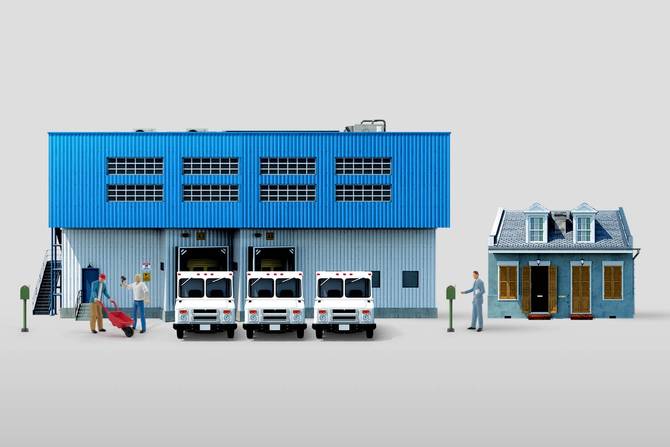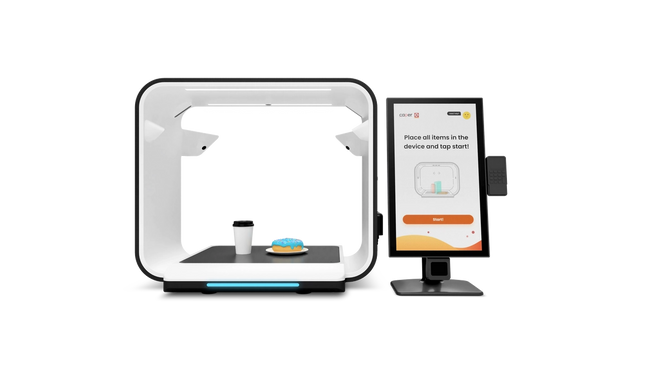Howdy. Happy Friday to those who celebrate. We’ve heard rumblings of pumpkin shortages and price hikes, so get ’em while you can and carve away this weekend.
In today’s edition:
- Neiman Marcus
 gift guides gift guides
- Companies stick close to ports
- Instacart eyes autonomous checkouts
—Julia Gray, Katishi Maake, Jeena Sharma
|
|
|
Neiman Marcus
What is a holiday season without a gift guide to help you placate your loved ones with material goods? Kidding. The gift guide has long played an integral role in retailers’ holiday strategies. And the wider shift to e-commerce has made it even more important to break through the noise.
For Neiman Marcus, Christmas is about curation. The department store first published its Christmas Book in 1926 as an extravagant 16-page booklet, filled with “fantasy gifts”(still a mainstay—what else would you call this $190,000 exotic gem, from 2020’s catalog?) and glossy holiday spreads. And this year, for its 95th edition, the stakes are high.
The motto for 2021 is “Celebrate big,” Neiman Marcus Group CMO Daz McColl told Retail Brew. Neiman Marcus wants to emphasize “giving as an experience” and capitalize on the pent-up excitement of a post-vax Christmas.
Presenting...how-to: NM’s gift guide is built from conversations between its merchants team, markets team, and sites team. They start with a theme, and curate products and promotions around that core idea. (Holiday planning typically begins 14 months ahead of Christmas.)
- Neiman’s gift guide is expected to drop on October 27 this year.
Neiman Marcus dubs its new direction, “Merry Charisma”—curated around the parts people play in consumers’ lives.
“This is a shift to the idea of getting back together with those you may not have seen for a while...thinking about [the] people who helped us through the last year,” McColl said. As such, this year’s gifting strategy “hinges on personality.”
- There are presents for your emergency contact, presents for girls’ night, and presents based on your friend’s favorite food, he noted.
“Gift guides are great at driving demand,” GlobalData Retail’s Neil Saunders told us. “They can be used as a tool to ensure gift buying is focused and relevant to the person and isn’t a wasteful expenditure.”
But just what should retailers consider to create a successful gift guide? From pricing to (yes) supply-chain concerns, click here to read more.—JG
|
|
|
Francis Scialabba
While some big-name retailers (cough, Walmart and Home Depot) are chartering their own ships to bypass global supply-chain disruptions, that’s clearly not an option for all companies.
Take Oak + Fort, for example. The Canadian apparel and lifestyle brand has, like most, struggled with everything from rising costs and weekly shipment delays due to the pandemic, to capacity constraints, and congestion at ports.
So in August, the company decided to outsource its US distribution to a third-party logistics company, NRI Distribution, in Fontana, California, just a two-hour drive from the port of Los Angeles.
“We had outgrown our previous facility and were holding goods in multiple locations,” Albert Sum, Oak + Fort’s director of supply chain, told Retail Brew.
Close to home: A number of companies prefer to keep their inventory near ports of entry like Los Angeles, Adam Petrillo, executive managing director in Newmark’s Industrial Advisory Group, told Retail Brew. But warehouse space in those areas is getting more expensive.
-
First-year base rents for industrial spaces in California’s Inland Empire, for example, increased 24.1% YoY through May, the second highest growth rate for US regions, per CBRE. (Northern New Jersey topped the list with a 33.3% bump YoY.)
- Warehouse sizes range from 10,000 sq. ft. to 500,000 sq. ft. Rent growth for bulk warehouse space larger than 500,000 sq. ft. grew the most at 13.2%.
Supply-chain volatility is also ticking up demand for warehouse construction in many major port cities. As of Q1 2021, the warehouse construction pipeline as a percentage of inventory in Savannah, Georgia, Charleston, South Carolina, and Norfolk, Virginia, is up 12.6%, 7.5%, and 7.3%, respectively, per Newmark Research. Each of those markets respectively have 71.8 million, 45.3 million, and 63.8 million sq. ft. of warehouse space, as of May.
Zoom out: “Broadly speaking, the folks that are midstream in the supply chain are having to store more inventory closer to where it’s being sold, so in the future if their supply chains continue to be disrupted…they’re not going to be caught without enough inventory to support their demand,” Petrillo told us.—KM
|
|
|
|
If you work in e-commerce, converting more customers, more often, and at higher value is music to your ears.
And SAP Commerce Cloud is like a musician here to bring you a sweet melody of e-commerce interconnectivity.
SAP Commerce Cloud connects your demand chain to your supply chain, and provides you with real-time insights about your customer, so you can provide them with a reliable, personalized, innovative, and engaging storefront (digital or physical, B2C or B2B).
This means they’ll be coming back for more, and your sales will keep going up.
Learn more today.
|
|
|
Instacart
The hottest club in retail is “omnichannel,” where retailers have convinced themselves that always-on is the way to a person’s heart...and wallet. Naturally, Instacart wants in.
In its bid to streamline the online and in-store shopping experience, the online grocery platform this week acquired the smart cart and autonomous checkout startup Caper AI for $350 million.
- By injecting Caper AI’s tech, Instacart wants AI-powered shopping carts and automated checkout counters to speed up the shopping experience. Time is money, after all.
What gives? Autonomous checkouts are gaining traction as consumers and retailers value the convenience and speed the tech offers.
- “I would expect in the next three to five years, autonomous checkout will be a common sight in grocery stores at least,” explained Ken Fenyo, president of research and advisory at Coresight Research.
- Instacart could be hoping that this new technology will cut down costs on a tech that requires substantial capital expenditures.
The partnership comes at a time when looming pressures, from labor shortages to changing consumer behaviors, are leading retailers to experiment with AI and smart technologies.
-
“Today retailers are squeezed for profitability due to supply issues, growing costs of store operations and labor,” Inna Kuznetsova, CEO of retail analytics firm 1010data, told Retail Brew. “[Retailers] increasingly turn to automation, including AI-based optimization of promotions and personalization of experience both for higher promotional effectiveness and cost reduction.”
Zoom out: The “smart retail devices” market is projected to be a $75 billion industry by 2027, and the smart shopping cart market continues to grow along with consumer preferences for contactless and express retail self-checkout counters. But questions persist.
“What are consumers willing to give up for the prospect of a completely frictionless experience?” Lucien Etori, VP, executive strategy director at digital-innovation consultancy R/GA, said. Will they be ok with the massive data harvesting this technology will warrant? I’m pretty skeptical.”—JS
|
|
-
Spanx founder Sara Blakely said the brand will expand into other categories like denim.
-
Ulta is giving small-format stores another go, after a similar move five years ago.
-
Gopuff introduces more than a dozen retail sites to New York City.
-
Amazon workers across four Staten Island facilities seek to unionize.
|
|
|
|
Grocery advertising is a mixed bag. With the accelerated shift to online grocery shopping over the past year, advertisers need to reach consumers in new ways. Streaming, shopping, watching, listening, reading, gaming: Reach your audience on and off Amazon. Tap into insights to shape your advertising campaigns and measure results with Amazon Ads. Learn more here.
|
|
Today’s top retail reads.
Stop the shop: The supply-chain shortage doesn’t mean consumers should buy in bulk ahead of time—it means consumers should curb their purchasing. (Vox)
Flashback: Classic 90s beauty founders are introducing brands for the TikTok generation. (BoF)
Now hiring: The labor shortage is hitting retail hard, as demand outpaces supply. (WWD)
|
|
Catch up on the Retail Brew stories you may have missed.
|
|
Three of the stories below are real...and one is most definitely not. Can you spot the fake?
-
Kellogg’s is being sued over a lack of strawberries in Pop-Tarts.
-
Supermarkets across America may be running out of juice boxes.
-
At Samsung, customers can design their own flip smartphone.
-
Ben & Jerry’s is introducing mac-and-cheese-flavored ice cream for the holidays.
Keep reading for the answer.
|
|
|
Sorry, you might have to stick to Kraft for that mac and cheese craving.
|
|
|
Written by
Julia Gray, Katishi Maake, and Jeena Sharma
Was this email forwarded to you? Sign up
here.
WANT MORE BREW?
Industry news, with a sense of humor →
-
HR Brew: analysis of the employee-employer relationship
Tips for smarter living →
 Podcasts →
Business Casual
and
Founder's Journal
Podcasts →
Business Casual
and
Founder's Journal
Accelerate Your Career →
-
MB/A: virtual 8-week program designed to broaden your skill set
|
ADVERTISE
//
CAREERS
//
SHOP
//
FAQ
Update your email preferences or unsubscribe
here.
View our privacy policy
here.
Copyright ©
2021
Morning Brew. All rights reserved.
22 W 19th St, 8th Floor, New York, NY 10011
|
|









